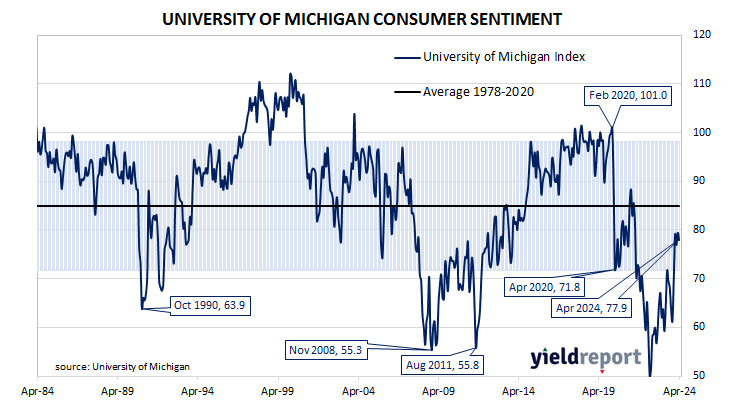Summary: University of Michigan consumer confidence index falls in April, reading less than expected; views of present conditions, future conditions both deteriorate; index moves sideways for fourth straight month; Treasury yields fall; fed funds rate-cut expectations firm; uptick in inflation expectations reflects frustration inflation slowdown may have stalled.
US consumer confidence started 2020 at an elevated level but, after a few months, surveys began to reflect a growing unease with the global spread of COVID-19 and its reach into the US. Household confidence plunged in April 2020 and then recovered in a haphazard fashion, generally fluctuating at below-average levels according to the University of Michigan. The University’s measure of confidence had recovered back to the long-term average by April 2021 but then it plunged again in the September quarter and remained at historically low levels through 2022 and 2023.
The latest survey conducted by the University indicates confidence among US households has deteriorated in April. The preliminary reading of the Index of Consumer Sentiment registered 77.9 in April, less than the 79.0 which had been generally expected as well as March’s final figure of 79.4.
Consumers’ views of current conditions and their views of future conditions both deteriorated relative to those held at the time of the March survey.
“Sentiment moved sideways for the fourth straight month, as consumers perceived few meaningful developments in the economy,” said the University’s Surveys of Consumers Director Joanne Hsu.
US Treasury bond yields fell almost uniformly across the curve on the day. By the close of business, the 2-year yield had lost 6bps to 4.89% while 10-year and 30-year yields both finished 5bps lower at 4.52% and 4.62% respectively.
In terms of US Fed policy, expectations of a lower federal funds rate in the next 12 months firmed, with at least two 25bps cuts currently factored in. At the close of business, contracts implied the effective federal funds rate would average 5.315% in May, 1bp less than the current spot rate, 5.275% in June and 5.25% in July. However, April 2025 contracts implied 4.655%, 67bps less than the current rate.
“Expectations over personal finances, business conditions, and labour markets have all been stable over the last four months,” added Hsu. “However, a slight uptick in inflation expectations in April reflects some frustration that the inflation slowdown may have stalled.”
It was once thought less-confident households are generally inclined to spend less and save more; some decline in household spending could be expected to follow. However, recent research suggests the correlation between household confidence and retail spending is quite weak.


